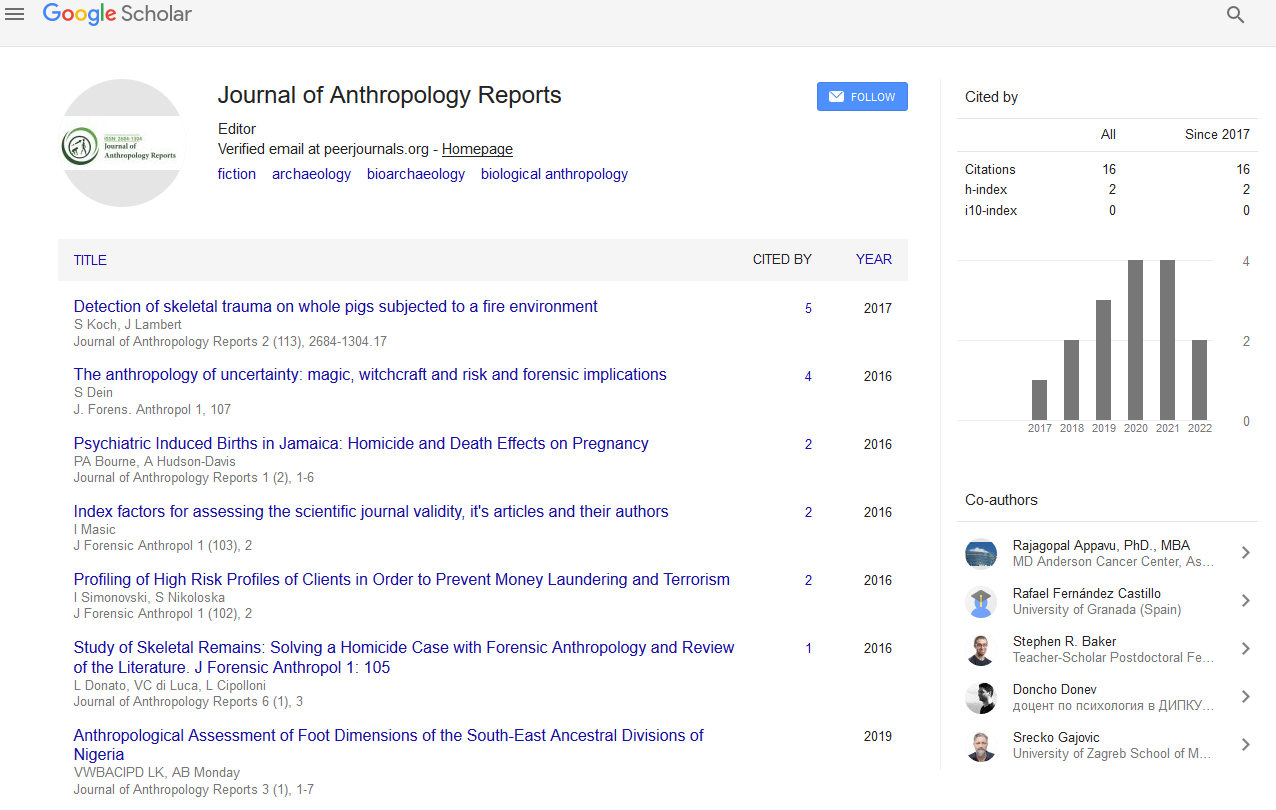Indexed In
- RefSeek
- Hamdard University
- EBSCO A-Z
Useful Links
Share This Page
Journal Flyer

Open Access Journals
- Agri and Aquaculture
- Biochemistry
- Bioinformatics & Systems Biology
- Business & Management
- Chemistry
- Clinical Sciences
- Engineering
- Food & Nutrition
- General Science
- Genetics & Molecular Biology
- Immunology & Microbiology
- Medical Sciences
- Neuroscience & Psychology
- Nursing & Health Care
- Pharmaceutical Sciences
Opinion Article - (2022) Volume 5, Issue 4
Verification of Psychological Variations, Causation and Social History Conflicting Patterns of Criminal Behavior
Maichaudo Gelvin*Received: 27-Jun-2022, Manuscript No. JFA-22-17381; Editor assigned: 29-Jun-2022, Pre QC No. JFA-22-17381(PQ); Reviewed: 13-Jul-2022, QC No. JFA-22-17381; Revised: 20-Jul-2022, Manuscript No. JFA-22-17381(R); Published: 27-Jul-2022, DOI: 10.35248/2684-1304.22.5.133
Description
Criminality is a characteristic or a state of criminal activity. Criminal behavior is characterized by a number of similar traits. Based on their underlying beliefs about human nature crime theories differ. Due to these beliefs and the known traits of criminals techniques for risk assessment have been developed and are now being used with some degree of accuracy. There is a tenuous and disorder-specific link between mental illness and crime. In many different ways, crime prevention tries to stop the emergence of criminal conduct. Even though it was initially divisive since the 1970s significant progress has been achieved in figuring out what works with offenders.
The idea that people with serious mental illness or developmental impairments should not be held accountable for their otherwise unlawful actions is a cornerstone of criminal justice. The idea itself has been the focus of much discussion and the ensuing issue of what to do with those who are judged not guilty due to insanity has led to varying standards. Testimony on these topics is one of the few actions of mental health practitioners that attracts as much media and public interest and causes as much controversy.
The insanity defense's history is a record of society's conflicts over issues such as moral obligation, religious influences, historical occurrences, the nature and extent of scientific understanding of mental disease and public perceptions of those who are mentally ill. For instance, it is thought that King George III's episodic mental illness had a significant impact on public opinion and as a result, the views of the jurors at the time. This may have aided some criminal defendants of the day. James Hadfield, Daniel M'Naghten, and John Hinckley are only a few instances when the criminal responsibility threshold was toughened after the perpetrator of an infamous crime was apprehended by National Geophysical Research Institute (NGRI). The changes usually result in the famed defendant being declared criminally liable under the newly altered standard.
Criminal behavior, especially aggressive and antisocial behavior is regarded as a significant social issue having multiple root causes. Numerous environmental, social, and psychological elements are known to be linked to a higher chance of conviction for this kind of criminality. Poverty, inadequate housing, high levels of social inequality, low educational achievement, a bad diet, low self-esteem and impulsivity are all interrelated variables. However, in the United Kingdom committing at least one crime is almost commonplace for young men with almost one-third of them having been convicted of a crime by the age of 30. Studies based on self-report reveal significantly greater rates of criminality in both men and women. Teenage years are when crime is most prevalent, and most young people grow out of crime.
Like other parts of an individual's psychological makeup criminality appears to be heavily inherited. Based on simple measurements the average heritability of psychological qualities appears to be 50% while estimates of the stable components of the traits or those that remain consistent following repeated assessment may be 70%. A highly reliable and stable characteristic such as Intelligence Quotient (IQ) has a heritability of about 75% for single assessments increasing to 85% when stability is taken into account. We know that the mean intelligence quotient of prisoners and delinquents who have been found guilty of crimes is a little lower than the average population so intelligence quotient may be important to criminality. It's likely that some of the more intelligent perpetrators have escaped detection and are not represented in these statistics. We might speculate that between 50 and 70 percent of the stable variance for personality, temperament, and interest qualities that are particularly related to criminality is genetically fixed in the overall population. Less than this 30– 40% of the population is currently at high risk for crime and delinquency.
According to the latter analysis, punishment is less likely to stop criminal activity brought on by an addiction; the only cure is therapy. This viewpoint is supported by studies that indicate reduced criminal recidivism after addiction treatment. These concepts have also sparked the creation of deterrents to incarceration like drug courts and similar diversionary schemes.
Addiction therapy that is compelled by a court order has been proven to be successful.
Citation: Gelvin M (2022) Verification of Psychological Variations, Causation and Social History Conflicting Patterns of Criminal Behavior. J Anthropology Rep. 5:133.
Copyright: © 2022 Gelvin M. This is an open access article distributed under the terms of the Creative Commons Attribution License, which permits unrestricted use, distribution, and reproduction in any medium, provided the original author and source are credited.

